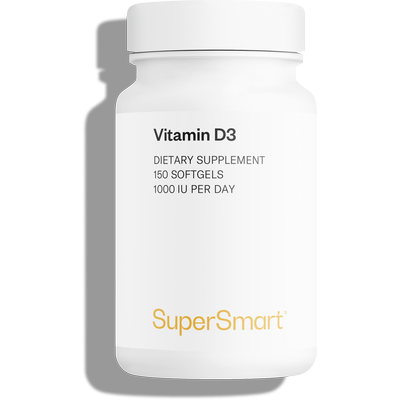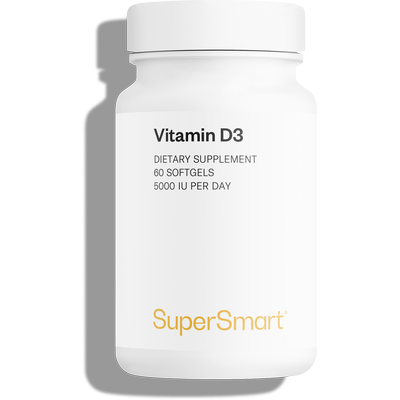24-01-2018
Vitamin D: widespread deficiency is reaching epidemic proportions
 Not only have modern lifestyles led to a fall in our activity levels but they’ve also made our vitamin D levels plummet! A new study1 has just shown that in half of all over-65s, blood levels for this vitamin do not reach the minimum amount recommended. What’s more, this minimum amount is calculated to meet basic needs only and is thus way below the level needed for optimal health.
Not only have modern lifestyles led to a fall in our activity levels but they’ve also made our vitamin D levels plummet! A new study1 has just shown that in half of all over-65s, blood levels for this vitamin do not reach the minimum amount recommended. What’s more, this minimum amount is calculated to meet basic needs only and is thus way below the level needed for optimal health.
Why has it become so difficult to achieve optimal levels of vitamin D?
Older people are not the only group to be seriously short of vitamin D, even if the risk of deficiency is higher for them. There’s a simple explanation for the widespread lack of this vitamin: humans are able to synthesise vitamin D from the action of the sun on the skin - specifically, the action of ultraviolet B rays on a cholesterol precursor. In the days when humans led a nomadic life, spending their days hunting and gathering outdoors, this process happened more or less continuously. The adverse effect on those unfortunate enough to inhabit regions with little sunshine was negligible: the paleness of their skin simply resulted in them producing more of the vitamin which was stored in their body fat for use when it was cloudy or during the winter months.
But what of today? Most of us in the West are closeted away in our offices from morn till night, only venturing out once in a while, and even then, covered from head to toe. And it’s even worse for old people, some of whom spend the whole day inside, and for whom the mechanism of vitamin D production is less effective anyway2. And what about people living at high latitudes who have darker skin compatible with high sunshine levels which absorbs more UVB rays, and who therefore require more sun exposure to produce the same amount of vitamin D? 3 And overweight individuals for whom part of their vitamin D is sequestered by body fat, thus preventing it from circulating in the bloodstream?
Vitamin D supplementation: is this the way forward?
Of course, it is theoretically possible to get round this problem by eating a vitamin D-rich diet. It’s an evolutionary response but it has its limitations: direct exposure to the sun, ie, hands, arms and face, without sun protection, can produce up to 10,000IU of vitamin D a day, while it’s very difficult in practice to ingest any more than 1500IU/day from the diet. Apart from fish, there are not that many dietary sources of vitamin D, and eating fish every day is not recommended for long-term health. So should we look to vitamin D supplements to compensate for our inadequate exposure to the sun? The scientists behind the above-mentioned study certainly think so (and they’re not alone). In the course of their investigations, they found that people who did supplement had far higher than average blood levels of vitamin D metabolites. And these blood analyses are the only markers able to indicate an individual’s vitamin D status!
What constitutes an optimal blood level of vitamin D?
A level below 20ng/mL indicates deficiency - that the body’s basic needs are not being met. This is the value adopted by the researchers for determining whether the seniors in their study were lacking in vitamin D, and it is also the figure used by health authorities from which to calculate daily recommended amounts (in France this is 200IU/day for adults). In reality, however, the level required for optimal health, ie, one that fully delivers the vitamin’s disease-preventing benefits, is well above this figure. Hundreds of studies show that optimal levels are somewhere between 40 and 100ng/mL, which is up to five times the minimum amount recommended4-5.
And to maintain such levels, you would need to obtain 4000-8000IU/day (including that gained from sun exposure) - levels that nowadays would be difficult to achieve without taking supplements …
A lack of vitamin D has thus become the norm, bringing with it increasingly widespread health problems. Low blood levels of vitamin D are associated with several conditions:
- greater muscle pain and weakness6 ;
- decreased bone mineral density (with increased risk of falls, fractures and osteoporosis) 7 ;
- cognitive decline, impairment of memory and executive function, increased risk of Alzheimer’s disease8-11 ;
- reduced immunity control (with a potentially higher risk of infection, or inversely, auto-immune disease12) ;
- symptoms of vascular dysfunction, particularly decreased ability of arteries to dilate properly13-16.
Which vitamin D supplement should you choose?
While it’s true that supplementation may not be natural, neither is our tendency to stay cooped up in our houses and offices. What it is, however, is a safe, reliable way of compensating for deficiency which we can unfortunately no longer do without if we want to avoid undue risk of disease. It simply remains to decide which supplement best suits your needs, particularly in terms of the dose which depends on four main factors: the levels of sunshine in your region, the time you spend outdoors each day, your age and how much fish you eat.
- If your job means you’re in an office all day, if you live in an area that gets little sunshine, or if you are over 65, it would seem wise to take a 5000IU vitamin D supplement every day for several weeks, in order to address your deficiency and replenish your vitamin D reserves, before moving on to one of 2000IU vitamin D.
- If you spend most of your day outside where levels of sunshine are good, a daily supplement of 1000IU vitamin D will suffice.
References
1. Romy Conzade, Wolfgang Koenig, Margit Heier, Andrea Schneider, Eva Grill, Annette Peters, Barbara Thorand. Prevalence and Predictors of Subclinical Micronutrient Deficiency in German Older Adults: Results from the Population-Based KORA-Age Study. Nutrients, 2017; 9 (12): 1276 DOI: 10.3390/nu9121276
2. Bischoff-Ferrari HA, Borchers M, Gudat F, et al. Vitamin D receptor expression in human muscle tissue decreases with age. J Bone Miner Res 2004;19:265-9.
3. Laura M. Hall, Michael G. Kimlin, Pavel A. Aronov, Bruce D. Hammock, James R. Slusser, Leslie R. Woodhouse, and Charles B. Stephensen. Vitamin D Intake Needed to Maintain Target Serum 25-Hydroxyvitamin D Concentrations in Participants with Low Sun Exposure and Dark Skin Pigmentation Is Substantially Higher Than Current Recommendations. Journal of Nutrution, first published on Jan 6, 2010 as doi: doi:10.3945/jn.109.115253
4. Holick MF. Sunlight and vitamin D for bone health and prevention of autoimmune diseases, cancers, and cardiovascular disease. Am J Clin Nutr 2004;80(6 Suppl):1678S-88S.
5. Garland CF. Vitamin D Supplement Doses and Serum 25-Hydroxyvitamin D in the Range Associated with Cancer Prevention. Anticancer Res Feb 21 2011
6. Lee P, Greenfield JR, Campbell LV. Vitamin D insufficiency-a novel mechanism of statin-induced myalgia? Clin Endocrinol Published online October 16, 2008:doi:10.1111/j.1365-2265.2008.03448.x.
7. Amin, S., LaValley, M. P., Simms, R. W., and Felson, D. T. The role of vitamin D in corticosteroid-induced osteoporosis: a meta-analytic approach. Arthritis Rheum 1999;42(8):1740-1751.
8. Constans T, Mondon K, et al. Vitamin D and cognition in the elderly. Psychol Neuropsychiatr Vieil. 2010 Dec;8(4):255-62. Review. French.
9. Annweiler C, Schott AM, et al. Dietary intake of vitamin D and cognition in older women: a large population-based study. Neurology. 2010 Nov 16;75(20):1810-6.
10. Llewellyn DJ, Lang IA, et al. Vitamin D and cognitive impairment in the elderly U.S. population. J Gerontol A Biol Sci Med Sci. 2011 Jan;66(1):59-65.
11. Llewellyn DJ, Lang IA, et al. Vitamin D and risk of cognitive decline in elderly persons. Arch Intern Med. 2010 Jul 12;170(13):1135-41.
12. Simpson S Jr, Blizzard L, et al. Latitude is significantly associated with the prevalence of multiple sclerosis: a meta-analysis. J Neurol Neurosurg Psychiatry. 2011 Apr 8.
13. Judd SE, Tangpricha V. Vitamin D deficiency and risk for cardiovascular disease. Am J Med Sci. 2009 Jul;338(1):40-4. Review.
14. Pilz S, Tomaschitz A, et al. Vitamin D supplementation: a promising approach for the prevention and treatment of strokes. Curr Drug Targets. 2011 Jan;12(1):88-96. Review.
15. Reddy Vanga S, Good M, et al. Role of vitamin D in cardiovascular health. Am J Cardiol. 2010 Sep 15;106(6):798-805.
16. Zittermann A, Gummert JF, Börgermann J. The role of vitamin d in dyslipidemia and cardiovascular disease. Curr Pharm Des. 2011;17(9):933-42.
Order the nutrients mentioned in this article

Healthy individuals now require a minimum dose of 1000 IU a day.
www.supersmart.comFurther reading
10-04-2019
Would you put your faith in a man who was twice awarded the Nobel Prize in two different categories? One of only two people (the...
Read more28-06-2017
As the control centre of the central nervous system, the brain has to deal with a constant flow of data, processing millions of bytes of...
Read more30-04-2018
A newly-published study in The Journal of the American Osteopathic Association shows that the body may be unable to make proper use of vitamin D...
Read more© 1997-2025 Fondation pour le Libre Choix
All rights reserved
All rights reserved
Free
Thank you for visiting our site. Before you go
REGISTER WITHClub SuperSmart
And take advantage
of exclusive benefits:
of exclusive benefits:
- Free: our weekly science-based newsletter "Nutranews"
- Special offers for club members only



















